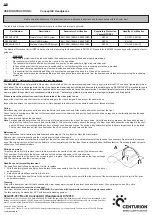
GB
USER INSTRUCTIONS:
ConceptAir Headpieces
The table below shows the ConceptAir Systems that are certified and relevant approvals.
Part Number
Description
Respiratory Certification
Respiratory Protection
Factor NPF/APF
Head/Eye Certification
R23CHFUVKIT
Helmet Visor PAPR System
EN 12941:1998+A2:2008 TH2P
NPF 50
EN 397 & EN 166
R23FUVNKIT
Visor PAPR System
EN 12941:1998+A2:2008 TH2P
NPF 50
EN 166
R23AWH9/13KIT
Welding Helmet PAPR System
EN 12941:1998+A2:2008 TH2P
NPF 50
EN 166 & EN 175
The Nominal Protection Factor (NPF) is derived from the laboratory tests undertaken in EN 12941. Please refer to EN 529 for country specific protection factor
guidance.
WARNING
•
Respiratory protection will be reduced unless the headpiece is correctly fitted and properly maintained.
•
No respiratory protection is given when the visor is in the up position.
•
The respiratory protection offered by visors and hoods may be reduced where high wind velocities exist.
•
In the unlikely event that the power unit is switched off or not functioning little or no respiratory protection is provided.
•
In the power off state a rapid build up of carbon dioxide and depletion of oxgen may occur.
•
It is essential that the assembly and fitting of any protective equipment be done in a “clean air” environment.
•
The wearer should leave the contaminated area and have all contamination removed from their person and clothes before removing the respiratory
protection.
R23CHFUVKIT - Helmet with Polycarbonate Visor Headpiece
The
R23CHFUVKIT
is a helmet with a flip up visor which is fed air from the waist mounted power unit via a spiral reinforced PVC hose and lightweight internal
air channel. The air is discharged into the top of the visor area maximising anti misting and directed to the breathing zone. R23CHFUVKIT is intended for use in
places where there is a defined respiratory hazard and the user requires head, face and eye protection. The industrial safety helmet is intended to protect the
wearer against falling objects and consequential brain injuries. The face/eye protection is intended to protect against impact and flying debris.
Please remove the protective cover from the outside of the visor prior to use.
Inspect the visor to ensure that there is no visible damage to the visor, browguard, headcover, faceseal or hose.
Inspect the headpiece to ensure that there is no visible damage to the helmet, visor assembly, headcover, faceseal or hose.
Fitting
Before donning the helmet connect the hose to the helmet and power unit and fit the waist belt with the buckle at the front.
Check that air is coming out of the front of the inner air channel in the helmet and adjust the head harness strap as required to comfortably position the head
harness on the head.
Don the helmet and tighten the headband.
Note:
For adequate head protection, this helmet must fit or be adjusted to the size of the user’s head. Adjust the helmet by means of the headband found at
the rear of the helmet for a secure and comfortable fit. This helmet is made to absorb the energy of a blow by partial destruction or damage to the shell
and the harness or protective padding and even though such damage may not be obvious, any helmet subjected to severe impact should be replaced.
Flip the visor down and pull the face seal under the chin ensuring a snug fit around the face.
Maintenance
Check before use that all parts are operational and undamaged. If in any doubt contact the manufacturer.
Replace visor covers frequently and the visor when scratched or damaged.
Other routine maintenance is limited to cleaning of the shell, hose and air channel, and replacement of the face seal as necessary. Do not modify or remove
any of the original component parts of the helmet or other respiratory parts other than those recommended by the Manufacturer. Do not apply paint, solvents,
adhesives or self-adhesive labels.
Fitting a new visor
To remove old visor, firstly remove the white stud located in the centre of the visor carrier (A) and remove visor.
To fit new visor, firstly locate the holes at both ends of the screen onto pegs in the screen carrier.
Apply gentle pressure at the front of the screen to push it in place. Then refit the white stud so that it goes though
both the visor carrier and the visor central hole.
Head/Face seal removal/replacement
The head /face seal is fixed by means of Velcro, to replace:
1. With the helmet placed on a flat surface, detach the hose assembly from the Air channel by holding the air channel firmly and twisting the bayonet fitting
anti-clockwise.
2. Detach the old Head/face seal from the Velcro.
3. Attach the head/face seal Velcro to the helmet Velcro, starting from the centre point follow the contours of the helmet ensuring that the joint is flat, even
and without creases.
Cleaning
Wipe with a damp (not wet) soft cloth soaked with warm soapy water to clean the helmet, hose and air channel. Dry by wiping with a soft dry cloth.
Do not allow water to enter the air channel.
Care must be taken to avoid scratching.
WARNING: Do not clean with commercial solvents or organic compounds.
The face seal may be washed at 40°C with domestic washing powder.
Centurion Safety Products Ltd
T: +44 (0) 1842 754266 | F: +44 (0) 1842 765590 | [email protected] | 21 Howlett Way, Thetford, Norfolk, IP24 1HZ, England
centurionsafety.eu
PPE Regulation (EU) 2016/425 or PPE Directive 89/686/EEC: EU/EC (as applicable) Type-Examination by: BSI Group The Netherlands B.V., Say
Building, John M. Keynesplein 9, 1066 EP, Amsterdam, The Netherlands (Notified Body No 2797) or BSI Assurance UK Ltd, Kitemark Court, Davy
Avenue, Knowlhill, Milton Keynes MK5 8PP, UK (Notified Body No. 0086) as specified on the product label.
Before using the headpiece, it is important that you read these instructions and those supplied with the Power Unit.
024-001-911 Rev B ConceptAir (Headpieces) 07/2019
A






















